#that one uses Hanakotoba
Explore tagged Tumblr posts
Text
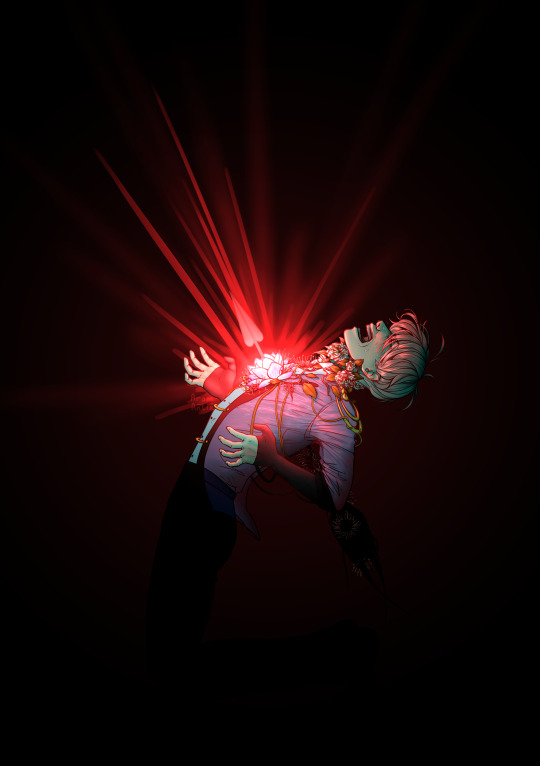
Viktuuri week day 6: Love
#no one said love had to be happy#love can also be the indescribable pain of abandonment and longing because some times cupids arrow just hits at the wrong time#and i love making my little paper dolls suffer#i had actually planned on making all the pieces for viktuuri week sad or angsty in some way but i ran out of time and fluff is so much fast#but ive had this piece planned since like july so i was NOT giving it up#also this is the only piece with my trademark flower symbolism and i couldnt just not stick to my brand#the flowers used are sacred lotus; red spider lily and camellia japonica dahlonega if you wanna know their meanings in hanakotoba#look at me being nice#giving you the names instead of you having to figure it out on your own#i really do sometimes forget that other people havent spent hour long sessions researching flower language and symbolism#so like if you wanna know the meaning of a flower ive used in a piece just ask#i will happily rant about my thought process#anyway ANGST#yes i did take great pleasure in getting to draw every detail of this and especially his pained facial expession#AND THE HAIR#drawing the highlights gave me life#and just MMM i loved drawing this so much#yuri on ice#yoi#yuri on ice fanart#yoi fanart#fanart#art#arom antix art#arom antix#viktor nikiforov#viktuuri week
42 notes
·
View notes
Text

HELLO HELLOO!! Here's my piece for the @blossominglovezine !!! Absolutely wonderful project that i am honored to have worked on :)
#floriography notes!!#the flowers at the edge of the bridge are japanese primrose#which i used as a representative of chastity and first love!!#and in the clearing is lavender! which i used in the context of both western floriography and hanakotoba#in western floriography it can represent serenity#and then in hanakotoba it can mean faithfulness!#(can also mean distrust#if you're interested in the angst)#cherry blossom trees mean life and death#and beauty (of the heart) and violence#which isn't super related? but can still be applicable#sakura blossoms themselves can mean spiritual beauty which is really similar to the meaning of the tree but i wanted to mention it because#i used cherry blossoms for susato's hair piece#one of them is just a darker pink#but the other is white#and white flowers as a whole generally mean grief or hope or purity/innocence#(the purity bit doesn't so much fit unless you're looking at it like it was a foil)#susato mikotoba#ace attorney#nikolina pavlova#nikosusa#the great ace attorney#dai gyakuten saiban#my art
30 notes
·
View notes
Text
I just realized that I use hanakotoba in my fics far too much.
My AC fics alone has:
the entire title of The White Aster of Masyaf
All Asters: Memories, Recollection/Reminiscence, Change, Same Feeling/Sentiment/Opinion, Believing in Love
Exclusive to White Asters: Please Believe Me
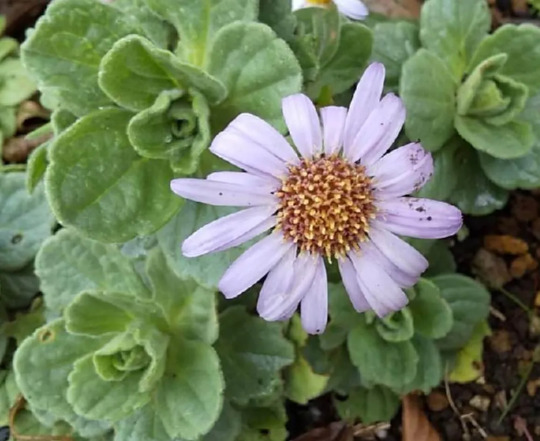
Ezio taking care of pink bougainvilleas in The King
Ezio sighed as he gently poured water over the pink bougainvilleas that were unofficially ‘his’. He had been the one taking care of them since he started to join Moussa in caring for the indoor garden. It wasn’t like there was anything else they could do but wait after all. In the past couple of months, Lara had been put into the Animus twice but that was all.
All Bougainvilleas: Passion, You are All I See
Exclusive to Pink Bougainvilleas: Overflowing with Charm, You are Full of Charm

The small white flowers (baby breath) Desmond planted in fiat mihi secundum verbum tuum
These flowers were just about to bloom such nice small white flowers all bundled together.
They were simple yet Desmond quite liked them.
Baby Breath: Innocent, Gentle/Kind, Happiness, Gratitude, Pure Heart, Trance/Ecstasy (like a dream-like state of pleasure)

And now, my next multi-chaptered AltDes has this:
“No, I… do not think so.” Malik shook his head before admitting, “It’s just… the flower carved on the lid…”
“I’ve seen it before. I believe it’s a native flower from where the Crusaders are from.” Malik informed them, his eyes trained on the box even as Altaïr placed it back inside the light red bag. Malik finally raised his face to stare at Altaïr as he said, “They call it St. John’s wort. They say it’s good for minor cuts and they’re usually burned during midsummer eve to drive away evil spirits.”
“Oh. That’s nice.” Kadar smiled brightly before tilting his head when he noticed Malik’s frown, “What’s wrong, Malik?”
“To the Crusaders, yes, it’s more or less a blessed plant but I know a foreign merchant that sells dried flowers of them.” Malik informed them, “He said, in his country, that flower symbolizes sadness.”
“Sadness?” Kadar repeated with wide eyes.
“‘To stop the sadness or to heal the sadness…” Malik recited before saying, “Those were the two main meanings of that flower.”
St. John’s wort: Secret, To Stop The Sadness/Sorrow, To Heal The Sadness/Sorrow

(I'm not counting Yew Branches since I used the western meaning of yew for that one)
(I guess I should be happy that Zero Eclipse didn't get hit by my hanakobota weakness. Then again... it's filled to the brim with Vega-Altaïr symbolism and I mainly use the tanabata star-crossed lover story for that one)
All flower images came from here
#yes i am already writing a new altdes fic#it wont be published until next year though#so i guess...#sneak peek#altdes#if you're curious about the new altdes fic#it's already 19k words and i'm only at chapter 4#it was meant to be a oneshot (sob)#teecup writes/has a plot#ac fic: fiat mihi secundum verbum tuum#ac fic: old master#ac fic: the white aster of masyaf#look hanakotoba is one of my longtime 'hobby'#it's not like i go searching for them whenever i write my fic#they just... happen#(it's only a serious problem if i start using wisteria)#otherwise we're fine#ac fic: beloved moon#ac fic series: yew branches
11 notes
·
View notes
Text
Flowers are often used as a metaphor for the female characters in the Apothecary Diaries. And for the first time, we, the viewer, are given the direct comparison to which flower is meant to represent Maomao: wood sorrel (also known as “cat’s foot”).

It’s a flower that can treat poisons. A flower that is used to enhance the beauty of the courtesans by painting their nails. A flower with a name associated with cats. A flower that, in hanakotoba, represents maternal tenderness. It’s also one of the flowers that Lakan specifically associates with Fengxian, and by extension, Maomao herself.
In the first opening—aptly titled, “Be A Flower”—the wood sorrel is the only flower that gets special attention. The other flowers are shown together with other varieties, but only the wood sorrel is shown by itself, and more than once.


We see it again in the second opening, with an infant being held by a parent, while flitting between images of Lakan and Fengxian’s backstory.

It’s such a simple flower, too. Small, unassuming, but full of diverse uses and qualities, be they medicinal or ordinary. A very fitting flower for Maomao, and what she brings to the story.
#the apothecary diaries#kusuriya no hitorigoto#maomao#fengxian#lakan#knh#mao mao#knh maomao#knh spoilers#apothecary diaries#apothecary diaries maomao#maomao apothecary diaries#neo queen serenity’s posts#tad meta#knh analysis#knh anime#kusuriya anime#tad#apothecary diaries spoilers#knh meta#knh episode 23#knh ep. 23#hana ni natte#be a flower
1K notes
·
View notes
Text
Flowers
Summary: what sort of flowers (or alternatives) they give you
Characters: Luffy, Zoro, Sanji, Ace, Sabo, Law, Kid, Usopp, Robin, Nami
Genre: fluff
———
Luffy: Not one to buy you flowers. Instead, he picks them. Sometimes they’re weeds he thought looked pretty, other times, he presents you with a lush bundle of pink carnations you think he must have picked from a commercial flower field (this man has no concept of private property). He’s always very proud to present them because he worked hard to secure them; you'd better give him a kiss for his effort. Has, on occasion, accidentally brought you some that are poisonous. Also once brought you a bundle of radishes because he thought you would like the color. Receiving flowers from Luffy can be a bit like receiving a lizard from your pet cat.
Zoro: He won’t really think to buy you flowers until one day you mention that camellias are pretty. He takes that to mean you like camellias, specifically, and not that you’d like to receive flowers in general, so he always buys you camellias, and you think it’s so sweet that you never correct him. He’s not actually a proponent of apology flowers because he thinks a ‘bribe’ cheapens it, but he will bring you flowers when he knows you’re having a hard day. He might also buy you a small bamboo plant that you two end up treating a bit like a pet, giving it a name and everything.
Sanji: Classic red roses, at least a dozen at a time. He’ll buy you roses in shades of white and pink, as well as the occasional yellow, but a dozen red roses is his go to. He also makes very good use of the petals. Doesn’t need a special occasion to present you with a bouquet. In fact, he always makes sure you have fresh flowers on your nightstand. Additionally, he’s learned to cook a few dishes with edible flowers in them for you, presenting you with all manner of chamomile, chive blossom, and pansy dishes.
Usopp: Will buy you cheap supermarket flowers on his way to come visit you and will regale you with a long, fanciful tale of crossing oceans and deserts to secure them from the only spot in the world those particular flowers grow, a tale filled with sweet and funny anecdotes that makes you giggle as you trim the stems and place them in a vase of water. He’ll tell you that the flowers have special powers and properties, such as bringing you luck or living forever so long as you smile every day.
Robin: Is an expert on hanakotoba, the language of flowers; she read a book on it once and thought it was so sweet and beautiful that she read it cover to cover several more times. She always buys you flowers with a specific meaning and then happily explains that meaning to you. Giving you flowers brightens her day as much as it brightens yours. White anemones (sincerity), daffodils (respect), and forget-me-nots (true love) are some of her favorites to give you.
Nami: Not a traditional kind of girl. She won’t hesitate to buy you roses if you like them, but she gravitates more toward violets, daisies, and the like, smaller flowers that speak to both of you. She’s also a proponent of buying you a single flower that you can put in your hair, and she has bought you a selection of floral hair accessories so you always have flowers for your hair on hand; her favorite is the primrose crown she bought you.
Ace: He’ll bring you bouquets with a lot of variety that the nice lady at the flower shop helped him put together. He usually builds these bouquets around sunflowers or orange lilies, and he gets very smug when his flowers brighten your day. He’ll also pick flowers for you, but he’s very conscious to only pick the ones that are not weeds. If he finds a field of sunflowers, you will be getting as many as he can carry. Never, ever visits you empty-handed, always brings at least a bouquet of flowers with him. Treats securing flowers for you like hunting for dinner and is always so proud of his bounty.
Law: Gravitates toward orchids, especially in darker shades of pink, purple, and blue; they feel a little moodier and less kitschy than the red roses Bepo tells him he’s supposed to buy to woo you (side note: imagine Law getting relationship advice from Bepo). One night folded an origami flower for you, and you liked it so much that he spent the rest of the night folding an entire bouquet, though he pretends it only took him five minutes. He doesn’t actually give the origami bouquet to you so much as he just sets it on your nightstand one day and mutters something about how the flowers won’t need water. He gets kind of annoyed if you make a big deal out of it.
Sabo: He’s gone for very long periods of time, so when he returns, he’ll bring you a bundle of peonies or calla lilies, but he also bought you a cherry blossom bonsai tree so you can have flowers even when he’s away. The bonsai tree ends up becoming his baby, and when he is home, he spends quite a bit of time tending to it, to the point you get a little jealous. But it brings you lots of comfort when he’s away, a symbol of your love that’s firmly rooted and eternal. Side note, he will most definitely use flowers to seduce you.
Kid: If it’s at the point where he’s buying flowers, this man is so far beyond pride he won’t flinch at purchasing a bundle of pink tulips, even if they clash with his outfit/aesthetic. He also presents you one night with a bouquet of metal flowers he made himself. He spent ages on it, but he really didn’t mean to. He intended to make one but got absorbed in his work and made an entire bundle of dainty little metal flowers. He’s oddly proud of himself for making something so delicate and would be crushed if you ever got rid of them.
———
Hope you enjoyed it! If you want more, you can check out my masterlist here!
#one piece#Luffy#Zoro#Sanji#Ace#Sabo#Law#Kid#Usopp#Robin#Nami#monkey d. luffy#roronoa zoro#zoro roronoa x reader#pirate hunter zoro#black leg sanji#vinsmoke sanji#sanji x reader#god usopp#usopp x reader#ace x reader#fire fist ace#portgas d ace#portgas ace x reader#flame emperor sabo#sabo x reader#trafalgardwaterlaw#trafalgar d water law#law x reader#trafalgar law x reader
738 notes
·
View notes
Text
If I'm with you, I'm happy

'If I'm with you, I'm happy' - the meaning of the yellow hyacinth, the flower that inspired me to make this in the first place ♡ /Print will be on the shop tomorrow / edit: print here! <3
Hanakotoba notes:
Hyacinth (general) - 悲しみを越えた愛 ‘kanashimi o koeta ai’ love that transcends sadness
Yellow hyacinth - あなたとなら幸せ ‘anata to nara shiawase’ if I’m with you I’m happy, 勝負 'shoubu' battle/match
Blue hyacinth - 変わらぬ愛 ‘kawaranu ai’ unchanging love
White hyacinth - 控えめな愛らしいさ 'hikaemena airashisa' reserved love, 心静かな愛 'kokoroshizukana ai' tranquil love
Purple hyacinth - 悲しみ 'kanashimi' / 悲哀 'hiai' sadness/grief/sorrow, 初恋の直向きさ ‘hatsukoi no hitamukisa‘ devotion of first love
Pink hyacinth - スポーツ sports, ゲーム games, しとやかなかわいらしさ 'shitoyakana kawairashisa' graceful cuteness (shitoyaka 'graceful' can also be translated as 'refined', 'modest', 'gentle', 'quiet' etc.)
Red hyacinths also exist but I didn't add them here as they didn't fit (meaning is 'envy')
Margaret - 真実の愛 ‘shinjitsu no ai’ true love, 信頼 ‘shinrai’ trust. There's also 恋占い koiuranai 'love fortune-telling' which I think may refer to that 'he loves me, he loves me not' game.
Twisted trees also have some nice symbolism to them (in general). What I'm about to say isn't something I found anywhere in particular, just my own thoughts about them. Disregarding the *hahaha* about the not-straight tree implications that I'm sure will be lost to no one single tumblr resident whatsoever- generally twisted trees are that way because of the winds they withstood (I mean there are other reasons too of course...). They're beautiful in their perseverance towards life. Life may have shaped you a certain way, with the good and the bad - and the shape you've taken is to be appreciated in its beauty... of simply being, and existing, and persevering despite all.
Link to the Hanakotoba site (set up so you can switch between JP and (auto)translation - keep in mind autotranslation is not perfect, in fact there are a few differences I corrected above) : hyacinths and margarets You can also search some words on jisho to see additional meanings, there are quite a few... I chose the ones I deemed most apt. Unfortunately you can't copy-paste the Japanese, I use the rikaikun extension for the kanji I don't know (which is most of them I gotta be honest). I have the JP keyboard installed and I just retype it to post it here haha.
#ace attorney#narumitsu#miles edgeworth#phoenix wright#wrightworth#gyakuten saiban#periwinkla#I hope I didn't mistype anything it's midnight and I'm quite sleepy.... hahaha#also if you're wondering about the lack of leaves on the tree?#for that there isn't really a reason beyond needing there to be space for the eye to breathe#but I suppose you could say it's as bald as the pining goofs will be soon enough-
393 notes
·
View notes
Note
Hmm for drawing requests maybe Solar and Moon shopping for some new clothes for Solar? Wouldn't have to do a background or anything it could just be mentioned in the dialogue lol
Or maybe one of them gifting the other flowers? I could see them tucking flowers between Solar's rays or into the brim of Moon's hat

bouquet, bouquet for my darling 💐💕
yes, I used hanakotoba for this because I love the meaning of flowers <333
#tsams#polaris stuffs#the sun and moon show#solarmoon#solar x moon#my art#tsams art#tsams solar#tsams moon#sams art#sams solar#sams moon
214 notes
·
View notes
Text

New collaboration with Loft & Amnibus was announced for Digimon Adventure!
Details about exact merch will follow soon, but the tweet states that the concept was decided by keeping the idea of 25th Anniversary in focus but the art itself is flower + wedding outfit themed. The collab will start in June which is considered a good month for brides in Japan and so we see many wedding themed anime illustrations get released during this time every year.
Now it is time for another certified Ayushi breakdown 🫡
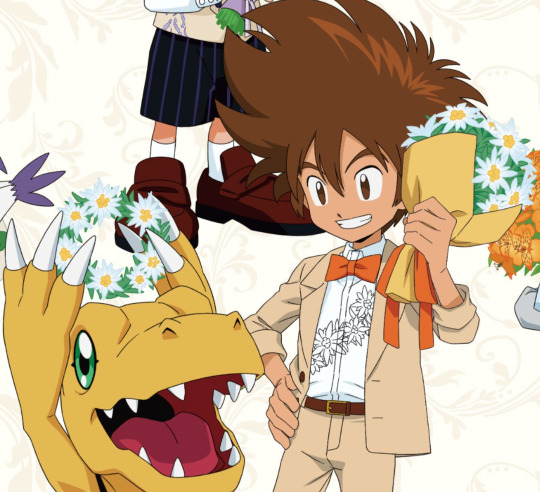
Taichi and Agumon are seen holding Edelweiss, with a pattern of the flower drawn beautifully on Taichi's shirt as well. Edelweiss in Japanese Language of Flowers (Hanakotoba) is meant to symbolise 'cherished memories/大切な思い出' and 'courage/勇気', while in Western Language of Flowers it's meant to symbolise 'noble courage' and 'daring' - both of which are apt for our best leader 🧡
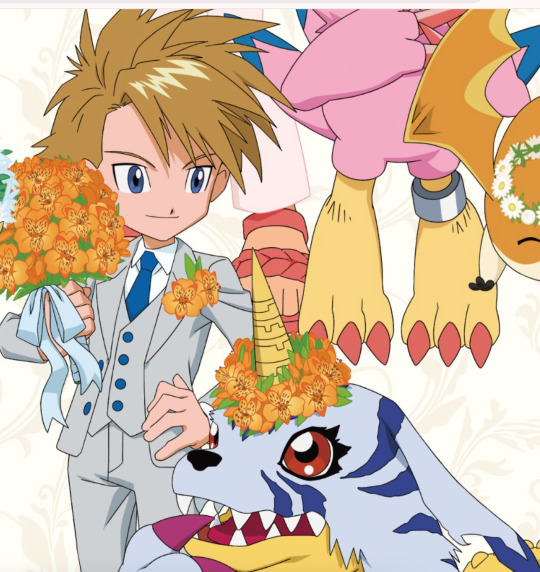
Yamato and Gabumon are seen holding Alstroemeria (Lily of the Incas, Peruvian Lily), and while the flower motif is not drawn onto his clothes, Yamato's coat's breast pocket is decorated with the flower as well. In Hanakotoba, Alstroemeria is meant to symbolise 'persistence/持続' or 'longing for the future/未来への憧れ', while in Western Language of Flowers it's meant to symbolise 'friendship' and 'devotion'. All meanings are apt for him imo, but especially persistence and longing for the future are very representative of his arc from the first series till Kizuna.
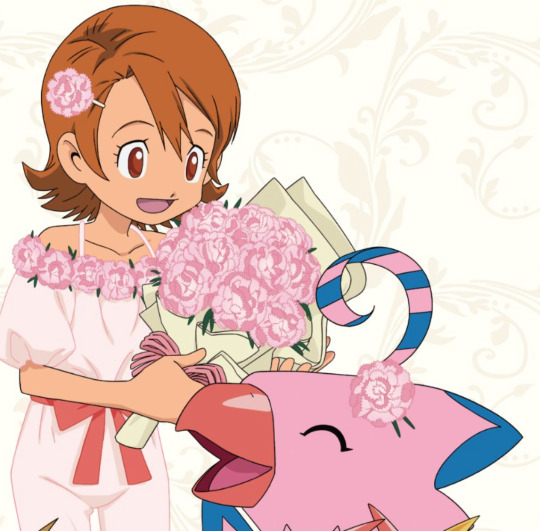
Sora and Piyomon are seen with Pink Carnations, with the neckline of Sora's jumpsuit lined with a bunch of the flowers. I personally love the visual of Sora in this pink jumpsuit, it plays into her slightly tomboyish yet extremely gentle personality so well! In Hanakotoba carnations symbolise 'innocent and deep love/無垢で深い愛' and pink carnations specifically symbolise 'love of a woman/女性の' 'passionate love/熱愛' and "beautiful gesture/美しいしぐさ'. In Western Language of Flowers carnations symbolise 'fascination' and love'. All meanings are pretty accurate for Sora, but red carnations are used to symbolise Mother's love in Japan so it would've been nice if they threw in a mix of red and pink to hint at her relationship with her mother!

Koushiro and Tentomon are seen holding Violet Sage, which at first glance I thought was Lavender. The flower pattern is also visible on his waistcoat and bowtie, which ties together his outfit very nicely! In Hanakotoba, Sage seems to have many symbolisations, 'respect/尊敬', 'wisdom/知恵', 'good home/良い家庭', and 'family love/家族愛'. But Blue (Violet) Sage specifically signify respect and wisdom. In Western Language of Flowers, Sage symbolises 'esteem', 'wisdom' and 'domestic virtue'. Again, a perfect choice for Koushiro, I personally would prefer to believe that they picked this not because of his crest but because of 'good home' and 'family love' since that part of Koushiro's arc in the first series was probably the most impressionable aspect of his character.
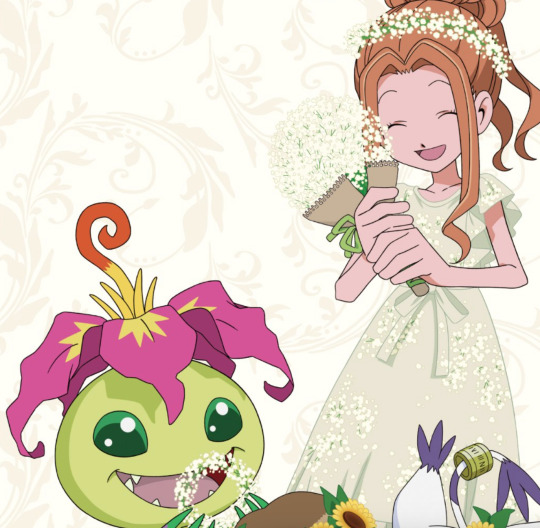
Mimi and Palmon are seen holding baby's breath, with Mimi's dress covered in a pattern of it. Even keeping my bias towards Mimi aside, this is possibly one of the prettiest outfit of hers till date, it genuinely looks like she's about to walk down the aisle as a flower girl for a very happy couple! In Hanakotoba, Baby's Breath or Kasumisou, symbolises 'pure heart/清らかな心', 'innocence/無邪気', 'kindness/親切', and 'happiness/幸福'. In Western Language of Flowers it symbolises 'everlasting love', 'purity of heart', and 'innocence'. All meanings apply to Mimi to the T, but they're also very apt for the whole wedding theme of the merch which makes this particular outfit + flower choice my favourite from the lot.
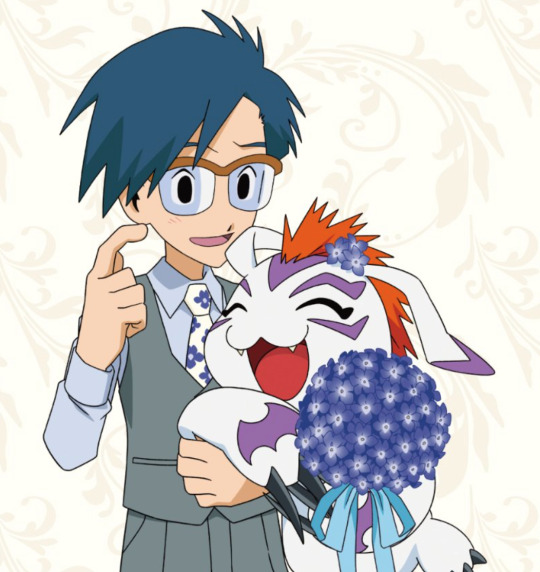
Jou and Gomamon are seen holding Violets or Sumire. I honestly struggled to figure out the flower for a while, at first glance I thought it was Periwinkle but since that was not mentioned in the Hanakotoba reference anywhere, I searched other people's interpretations and settled with Violets. His tie also has a cute pattern of the flower, and it makes me wonder if Koushiro and Jou went shopping for their outfits together! In Hanakotoba, Sumire symbolise 'modesty/謙虚', 'sincerity/誠実', and 'small happiness/小さな幸せ'. Depending on the colour, the symbolism can change in Hanakotoba, and purple Violets specifically represent 'fidelity' along with 'love'. In Western Language of Flowers it symbolises 'modesty' and 'faithfulness'. This is as Jou as a flower can get lol.
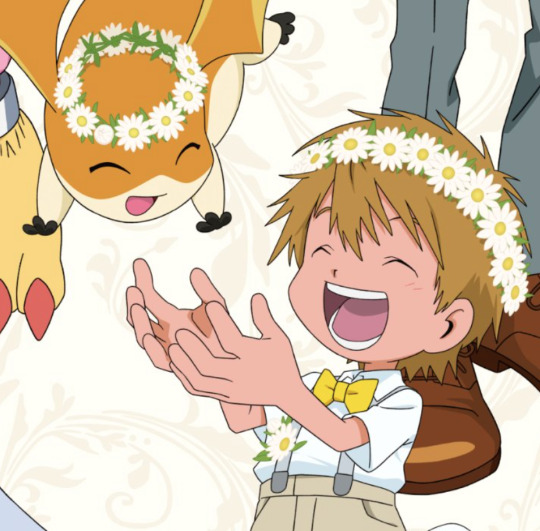
Takeru and Patamon are seen with White Gerberas. Like Yamato, Takeru's outfit doesn't have a pattern of the flower, but the Gerberas themselves are pinned to his suspenders. In Hanakotoba, Gerbera symbolises 'hope/希望' and 'always moving forward/常に前進'. White Gerbera specifically are used to symbolise 'hope' and 'honesty/律儀'. In Western Language of Flowers it is meant to symbolise 'cheerfulness' and 'beauty'. All meanings are accurate for Takeru, no comment needed!
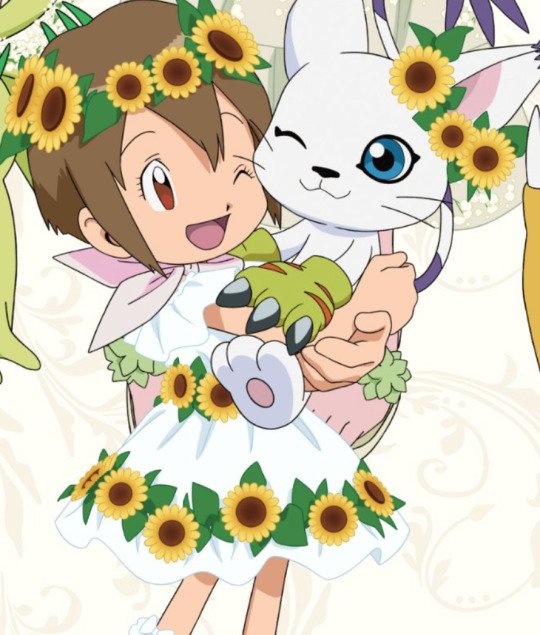
Hikari and Tailmon are seen with Sunflowers. I personally feel that Hikari's outfit is a little too much compared to the rest, just the sunflower belt would've been enough but they added that extra line at the hem and it's kind of an overdose. In Hanakotoba, Sunflowers symbolise 'I gaze only at you/私はあなただけを見つめる', 'adoration/愛慕', and 'worship/崇拝'. In Western Language of Flowers, it symbolises 'adoration' and 'false riches'. I understand that they wanted to go with a bright or perky flower for Hikari but something like a Pink Aster which symbolises patience or Cosmos which symbolises harmony, peace etc. might suit Hikari better given the overall theme of the illustration. The only miss in the otherwise perfectly depicted theme and art!
#digimon#digimon adventure#taichi yagami#yamato ishida#sora takenouchi#mimi tachikawa#koushiro izumi#jou kido#takeru takaishi#hikari yagami#agumon#gabumon#piyomon#palmon#gomamon#tentomon#patamon#tailmon#digimon merch news#digimon commentary#ayushitposting
178 notes
·
View notes
Text
youtube
This opening is replete with symbolism.
Flower language has been a recent fascination of mine.
Do you want to make my new hyperfixation your problem? If so, then let's take a deep dive into the first opening before the new one airs tomorrow.
Before I start, here are a couple of things to keep in mind.
While the use of flower language in this show mostly lines up with Japanese hanakotoba, there are still a number of flowers here that hold particular significance within Chinese culture, and thus have additional meanings that don't line up with those from Japan. I’ll be mentioning them alongside the Japanese meanings where I deem it relevant.
The following will contain light spoilers of content from the novels/manga which has not been animated at the time of writing. I'll try to be vague and sparing with it, but there are a few flowers I can't discuss without them.
Past the title card, the opening begins with eight blooming flowers dancing through the frame in rapid succession. These represent the storylines covered by the first cour of the anime in order of appearance, and each can be found in the episode(s) they signify. From the top:
Rhododendron: This plant is all over the first two episodes, so I'm going to cover its appearances before delving into its meaning. In episode one, there are two shots of the buds of this plant, one as Lihua gives birth, and then again as the doctor examines her baby. They're finally shown in full bloom as one of her ladies disregards the branch Maomao used to warn of the toxic makeup. In the following episode, Gyokuyou has seemingly taken a liking to the flower that saved her daughter's life, and a few clusters can be seen in a vase during several shots before Maomao uses them as an example of a seemingly innocuous plant that could cause accidental poisoning, and indeed, if you look closely at the background during the scene with the soldiers, you can see what appear to be rhododendron shrubs. There are actually quite a few different possible meanings for the many granular varieties of Rhododendrons/azaleas. Luckily, the characters said the name of the plant out loud for me: shakunage. So, this is Rhododendron subg. Hymenanthes. In hanakotoba it means dignity and majesty, but also, on account of its poison, danger and caution. Those last two meanings clearly line up with its ominous usage in these first episodes, growing and maturing as the babies grew sicker. But in addition to their function as a warning of danger, I think there's a case to be made that they also represent Gyokuyou herself. As I stated earlier, she starts keeping them after the first episode, and Hongniang later starts growing the closely-related azaleas in the jade pavilion as well. As for how its meanings apply to her, Gyokuyou is regal, magnanimous, and never loses her composure (unless it's at Jinshi's expense lol,) but she's also described by Gaoshun as shrewd and cautious, being unwilling to hire any lady she doesn't absolutely trust, and constantly gleaning information to send back to her family. These all fit with the dual meanings of rhododendron. In Chinese culture, rhododendrons and azaleas represent womanhood and passion, as well as home and a desire for homecoming.
Cotton rose: A type of hibiscus, this represents Fuyou, decorating both her person and her chambers in episode 3. It means 'delicate beauty' and 'graceful lover.' I think these are referring to both her skill in dancing, as well as her affectation of frailty and neuroticism. As far as I could dig up, its unique tendency to change color based on the time of day doesn't have particular bearing on its meaning in either Chinese or Japanese culture, but the story itself uses it as a metaphor for Fuyou hiding her passion, will, and cunning behind a wallflower exterior.
Balloon flower: In hanakotoba, it represents undying love, sincerity, and grace. These grow in the crystal pavilion, adorn the iconography of Lihua's furniture, and likely inform her blue and violet color scheme. Its last two descriptors gesture towards Lihua's style and personality. She's elegant and staid, but she also takes everything quite seriously, and wears her heart on her sleeve. As for the undying love element, I see that as alluding to her love for her son, her agony at his passing, and her hopes of reclaiming that love again through having another child.
Violet: This one actually tripped me up for the longest time. The flowers in the opening looked like hostas to me, but no matter how closely I looked at the backgrounds in this show, I couldn’t find anything along those lines. Eventually though, I caught on that these must be the violets from episode five, even if they’re a different color from those shown in the episode. And also droopier. Anyway, violets mean humility, sincerity, and ‘a little bit of happiness.’ In the episode proper, they are crushed underfoot as Maomao narrates about the lengths she had to go to keep herself safe while growing up in the red-light district, illustrating how even the modest aspirations of an ordinary peasant are in perpetual danger in such a cutthroat environment.
Chinese aster: Daisies and asters are my least favorite flowers to identify. They all look the same. As such, I’m a little less confident about this one, but I think it’s a Chinese aster. The leaves and buds look similar, and the context in which it appears in episode six suits its meaning. As Lishu’s ladies disparage her so-called pickiness, a shot of this flower opens the episode. While the Chinese aster’s meaning changes based on color, white in particular means ‘please believe me.’ I think that speaks for itself
Toad lily: This appears twice during episode eight, where Maomao gets drawn into the mystery of an attempted murder during her vacation. Toad lilies symbolize hidden thoughts and intentions, alluding both to the possible conspiracy on the part of the women of the brothel, and to the fact that Maomao will never really know the truth of the incident, having to content herself with speculation.
Sacred bamboo: This one is easy to miss, because while the plant is in full bloom in the opening, it’s laden with berries in the show proper. This is Nandina, a.k.a. the sacred bamboo, a mainstay of autumn and winter floral arrangements in both China and Japan. It’s considered auspicious, symbolizing a reversal of ill fortune into prosperity--the precise opposite of how it’s presented in episode nine of the show. There, Maomao fiddles with the plant as she contemplates all the instances she’s seen of good fortune being struck down by tragedy, and the prospect of that same sword of Damocles falling upon her head as well, a harbinger of eucatasrophe being used to symbolize straight catastrophe. Also worth noting is the fact that the plant is very poisonous, so much so that it has a reputation for killing any birds which try to eat its berries; I think that bit of trivia might be the inspiration behind the decision to ironically invert its lucky image. In addition to its central appearance in episode nine, it can also be seen in Lishu’s chambers in episode ten, mixed in among the vases of white camellias.
Japanese azalea: These mean passion and steadfastness, alluding, in my view, to Fengming’s devotion towards Ah-duo. Fun fact: did you know that honey made from toxic azaleas, termed ‘mad honey,’ is sometimes manufactured on purpose? It’s not super legal in most of the world, but apparently it can be used as a psychedelic.
After this, we see a panning shot of seven flowers, with the top four representing the high-ranking concubines, and the bottom three representing the high-ranking courtesans. While the first set of flowers grew from buds and flew across the screen, this set consists of still images. If I were to hazard a guess as to why, I'd say that it's because those previous flowers were conveying the movement of emergent stories, while these upcoming flowers portray the relatively static personality traits of individual characters. I'm going to tackle these in reverse order, as the first three flowers to appear are somewhat tricky to talk about.
Peony: This flower represents Gyokuyou, and in addition to appearing in her non-diegetic floral backgrounds, it also decorates the tapestries of the jade pavilion. In Chinese culture, peonies are one of, if not the most, important flowers. They represent feminine beauty, pride, honor, renown, wealth, prosperity, high-status, opulence, and a nobility of spirit. They are considered to be the king of flowers, and were historically only permitted to be grown by nobility. All of these superlatives are likely alluding towards Gyokuyou's status as the emperor's favorite consort, with the best shot at becoming empress.
Balloon flower: See above.
Lily-of-the-valley: This means purity, chastity, humility, and 'happiness will come again.' While the first three all seem to fit Lishu on their face, I find myself curious about the fourth meaning. I'm only partway through the third novel, but if this indicates that, at some point in the future, Lishu finally catches a break, then I'll certainly be happy to see it.
Dendrobium: In China, orchids in general are associated with elegance, refinement, and good taste, which fits with Maomao's description of the garnet pavilion as being beautiful in a minimalist sort of way. They also represent the virtues of an ideal gentleman-scholar: integrity, humility, temperance, and nobility. Furthermore, they are considered emblematic of spring; it, along with bamboo, chrysanthemum, and plum blossom, represent the four seasons. Returning to Japanese symbolism, the flower associated with Ah-duo seems to specifically be Dendrobium nobile. Nobile in particular means 'honest and to-the-point' in hanakotoba, likely alluding to Ah-duo's candid personality, and the fact that she is on casual terms with the emperor.
Regarding the final three flowers, the show itself doesn't explicitly tie any one of them to a particular courtesan--their flowers only appear as a group in episode twelve. But, by contemplating their meanings, and with some help from the characters' wiki pages, we can make some educated guesses.
Yulan Magnolia: This one, I'm guessing, represents Joka. On one hand, I'm kind of dumping her with this because the other two flowers just seem to fit the other two courtesans better, but its attributes nonetheless seem to accord what we know of her character--which admittedly isn't very much. In hanakotoba the yulan magnolia means nobility, sublimity and a love of nature. In China, its pretty similar: purity, nobility, dignity. It's also worth noting that they're commonly planted around Buddhist temples in China, and have been for many centuries, granting them an air of spiritual profundity. Joka is said to be aloof and cold, which is part of her appeal as a courtesan. While chrysanthemums and plum blossoms have a warmer aspect to their meanings, the loftiness of magnolia hews more closely to her characterization. Then there's the matter of her name, which is apparently a stage name. It translates to 'Lady Ka' (or 'Hua,' if you want to go with the Mandarin pronunciation.) Now, the 'ka' in her name is written as 華, and in the story, that character is only permitted to be used by the emperor and his family. So, for her to use it, even as a stage name, is a pretty bold pretense to nobility.
Chrysanthemum: In Japan, chrysanthemums are associated with nobility and the imperial family. In China, they are associated with longevity, endurance, and vitality, on account of their long-lasting blooms that persist late into autumn. I think this is most likely to be Pairin's flower. She's one of the few courtesans who's in her line of work because she wants to be, and is flourishing in an environment where others are desperate and debt-ridden. That covers 'vitality,' and Lihaku can attest to her endurance, if you know what I mean... Moving on, its mentioned in the novels that she's actually in her thirties, but still looks quite young, again harkening to the chrysanthemum's persistence.
As far as symbolism is concerned, chrysanthemums do seem to fit her character better than magnolias. But, something that gives me pause is her name, which means 'white bell,' on account of yulan magnolias being white and having a bell-like shape. I still think it's most likely that the chrysanthemum, and not the magnolia, belongs to her, but it was too notable a coincidence to not at least mention.
Plum Blossom: We can safely assume this one refers to Meimei, as her name is written with the character for plum. As plum trees are among the earliest to bloom each year, and will even bloom while snow still covers their branches, both China and Japan associate them with resilience, hope, inner-strength, and renewal. We don't know much about Meimei either, but my impression of her is that she seems to be the nicest and most even-keeled of Maomao's sisters.
Following this parade of showy flowers, we finally glimpse the emblem of our protagonist, Oxalis corniculata, the creeping wood sorrel, downcast and huddled amidst the underbrush of a forest. Whereas the other flowers we've seen thus far are primarily ornamental (even if some are also edible/medicinal,) wood sorrel is herbaceous and weedy, and is unlikely to grace any vases, wreaths, or arrangements. If it were spotted in a noble's garden, it would likely be uprooted, but to the peasant who finds it growing in a ditch, it's a tasty snack.
In hanakotoba, wood sorrel means joy, 'shining heart,' and 'a mother's love.' All three descriptors, I believe, are relevant to Maomao's character. Despite her flat affect, Maomao has a strong passion and sense of joie de vivre driving her through life. Those further along in either the novels or the manga will recognize 'a mother's love' as (somewhat ironically) gesturing towards her complicated relationship with her mother. As for 'shining heart,' I think that will become apparent as we go further through the opening.
But, before we do that, I'd like to take a moment to examine the moments when wood sorrel appears in the show itself. Thus far, by my recollection, it has appeared in episodes one, three, and twelve. The opening shot of the first episode is of a wood sorrel, informing the viewer in no uncertain terms that this is Maomao's flower, (in case the opening was too subtle.) In the third episode, several wood sorrels dot the field where Fuyou sits with her lover, symbolizing how Maomao has aided and protected them. In episode twelve, a single wood sorrel is tucked inside a lavish bouquet of her sister's flowers, a visual gag paralleling them fussing and fawning over her.
Returning to the opening, Maomao is shown contemplating a subtle glow in her closed hands while a reflected, sunlit version of herself glances back at her. Then, as all the previous flowers fall away, as Maomao casts the light up into the air, its glow illuminating her face, the wood sorrel finally stands upright, and blooms in full.
Now is a good time to mention a relevant characteristic of creeping wood sorrel: it only blooms in direct sunlight. When crowded by other plants, it curls in on itself, closing both its flower and leaves. This serves as a clear metaphor for Maomao's personality; under most circumstances, she seeks to be invisible and unobtrusive, but when she's in her element, she commands attention and respect.
Following this, we have her magical girl-esque transformation sequence, with her outstretched hands forming the shape of a blooming flower as she dances through a whirl of yellow wood sorrel petals. She then bows down in imitation of the flower, taking the light back into her chest (there's that shining heart I mentioned earlier,) as she dissolves into the stoic, unassuming version of herself once more, closing out the opening. (Jinshi who?)
I'd like to end this analysis with an observation. While the real wood sorrel exists at the perpetual mercy of outside forces, Maomao is not merely reacting to a light source that exists beyond her control. The light exists within her, and she chooses when it will shine down for all to see, and when she will hide it away in the depths of her heart. To those who've gotten this far, thank you so much for reading.
#the apothecary diaries#i like being mean to a certain someone#but i will note that i'm familiar with the interpretation that the lyrics of the op are written from his perspective#and i would agree that that reading has merit
183 notes
·
View notes
Text
Hanakotoba and the Meanings of Flowers in SK8 the Infinity
Ranging from very overt allusions in the text to single pieces of official art, almost every main character in SK8 has been associated with a flower. Hanakotoba, the Japanese language of flowers, is something that the creators were attentive to, evidenced by its mention both in the show itself and by staff in discussion about the episodes, and considering how hanakotoba might have been taken into account in the other examples of flower imagery can add an interesting layer of symbolism to speculate on.
The hanakotoba columns on GreenSnap were my primary source for this post, but I've crosschecked the meanings on multiple websites as much as possible to ensure the factual information here is accurate to the best of my ability. This is quite a long post, so bear with me.
🌹 Roses 🌹
Naturally, the first flower to start with is the one that is directly mentioned in the show itself:
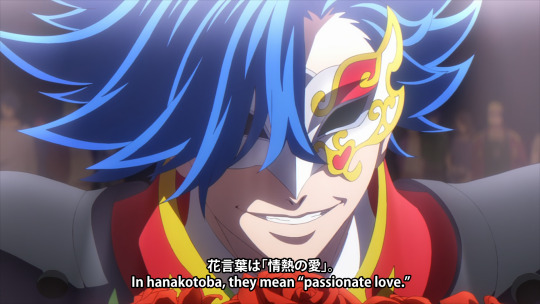
As Adam says, red roses do mean "passionate love", though his particular wording (jounetsu no ai) is slightly paraphrased from how that meaning is typically worded. (If you look up the meaning of roses in hanakotoba, you may see netsuretsu na koi (熱烈な恋) instead.) They can also simply mean "love" and "passion" (ai and jounetsu, as Adam uses in this line), as well as "beauty" and "I'm in love with you."
In Japanese as in English, red roses are a very classically romantic gift, so in the finale and the Blu-ray box art, it seems Adam's passionate love hasn't waned.

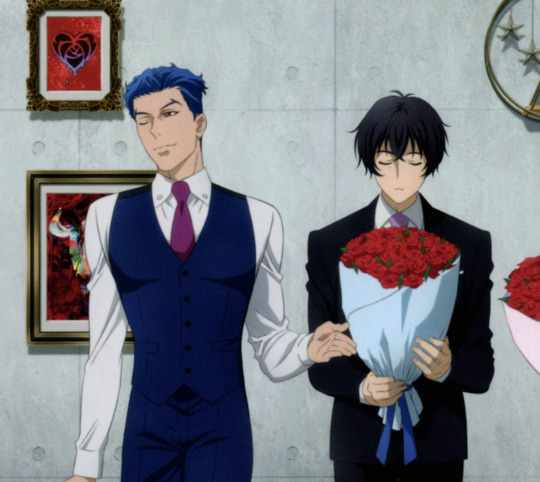
There are also specific meanings for certain numbers of flowers in a bouquet of roses, and while it's never stated how many roses are in the first bouquet Adam brings Langa, extrapolating from how many flowers are visible in the shots and how many are hidden, as well as the bouquet at Adam's birthday display at the 2022 NAMJATOWN collaboration containing 50 flowers (as I was able to confirm from some fans' photos from better angles, that I won't be reposting here as they were personal photos on Twitter) I believe that the bouquet in the show also contains 50, which means "eternity."
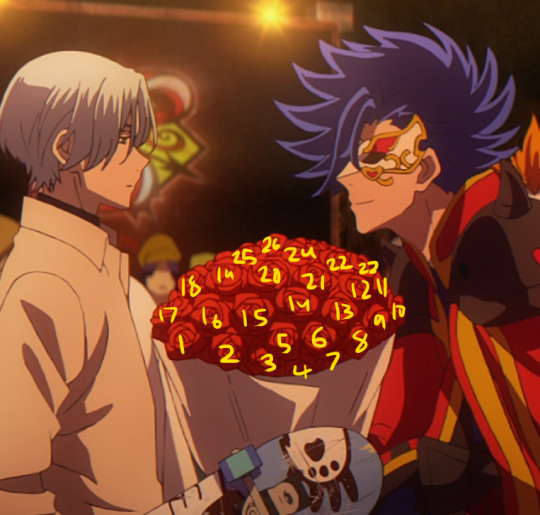
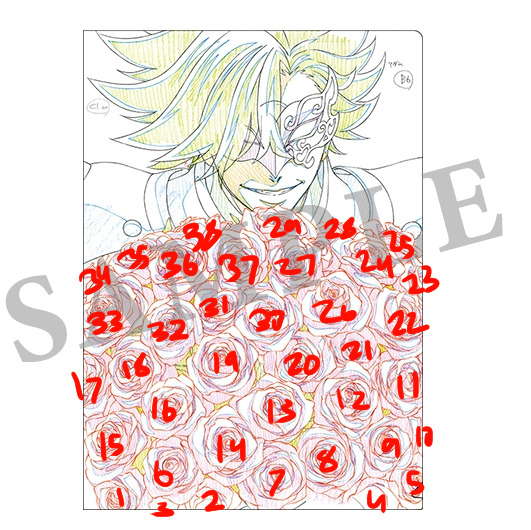
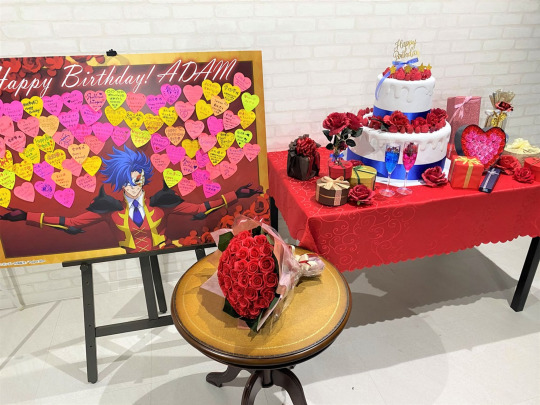
Adam's bouquets to Langa are also not the only times roses appear in relation to him, nor is red the only color they appear in. Several flashback shots of Ainosuke and Tadashi as children feature red roses, which has quite clear subtextual implications, especially alongside the comparison between Tadashi and Langa made in the show itself.
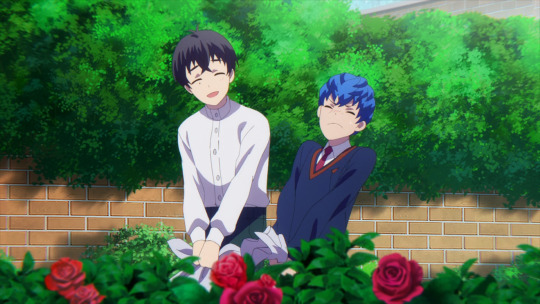
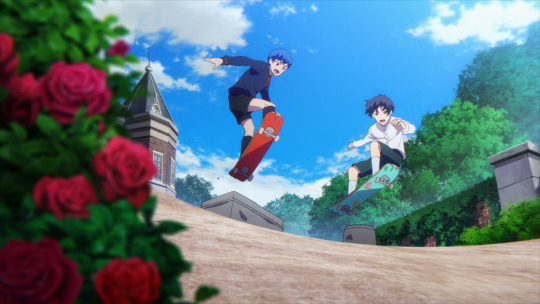
But one prominent flashback also includes pink roses, meaning "deep impression."
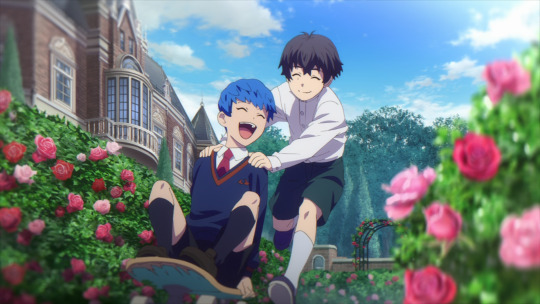
In Ainosuke and Tadashi's last scene together in the finale, there's a vase of purple roses behind them, meaning "pride" or "respect."
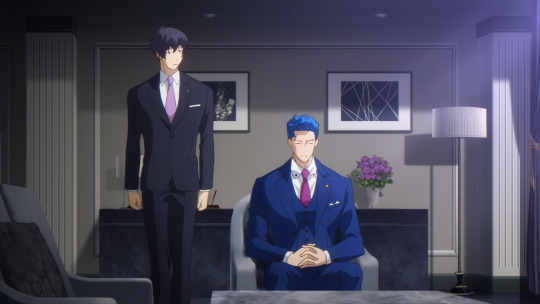
And his graffiti tag from the 2022 Infinity Week art features blue roses, which, along with being in Langa's image color, mean "dream come true", "impossible" or "miracle."
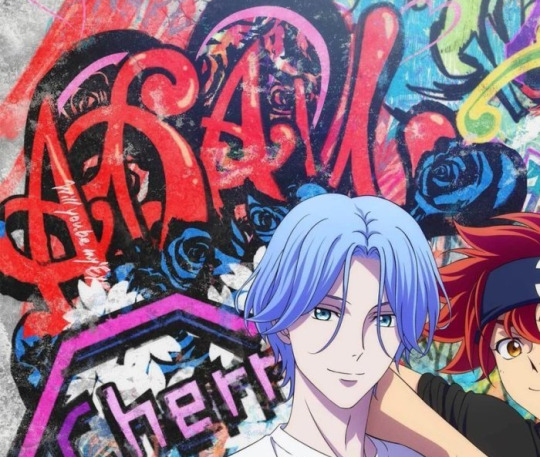
Roses also have a lengthy history of associations with gay men, both in real-life Japanese gay culture and in the boys' love genre, and how this relates to the use of rose imagery in SK8 could (and likely eventually will) be its own post, but it's an extra aspect to take into consideration with Adam especially.
As a bonus, the mangaka for the official manga adaptation also drew Langa and Reki with red and blue roses (respectively) to celebrate the season finale:
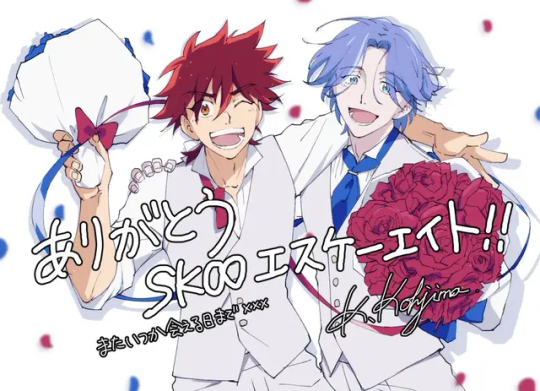
And while Reki is never associated with roses in any more official capacity, Langa does have red roses in his house that are visible in a few scenes:
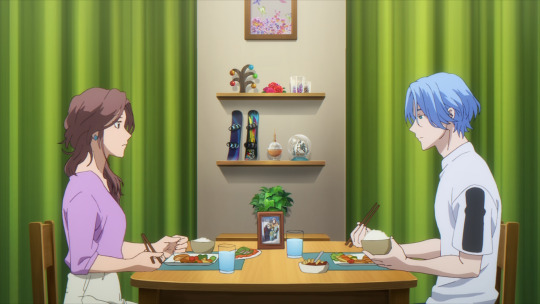
~
🌷 Tulips 🌷
This is another one that's directly confirmed, this time regarding Shadow's bouquet in the ending montage.
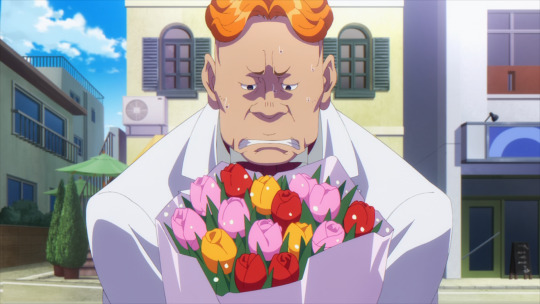
For love bouquets, Adam uses roses, so Hiromi-chan's was tulips and white baby's breath. In hanakotoba, red tulips mean "confession of love." Pink means "sincere love." Orange means "shyness", so we went with these three. Plus, white tulips are "new love" or "unrequited love" so we stopped there… (lol) By the way, in hanakotoba, baby's breath means "innocent love" and "gratitude."
(Episode 12 Director Masatoyo Takada, Skater's Backstage)
Tulips in general mean "charity" and "thoughtfulness", and Shadow is frequently associated with them outside of just this scene, whether on his clothes or in official merchandise. "Tulip" is also the name of the flower shop where he works!
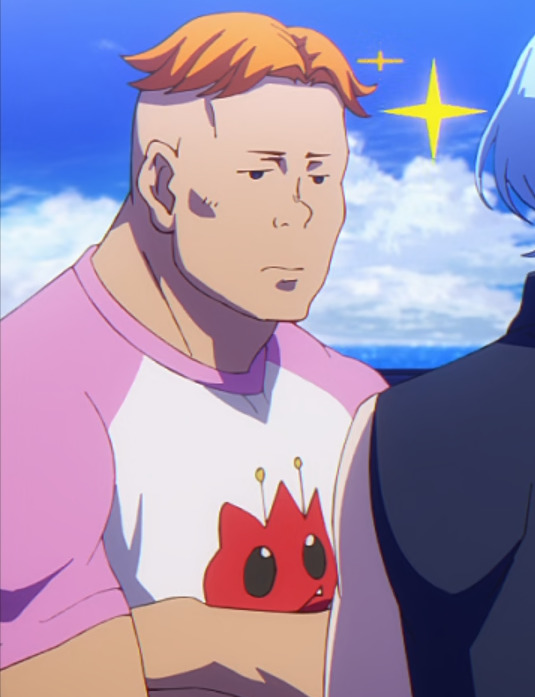
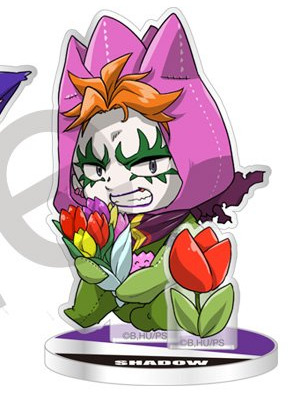

He's holding another bouquet of tulips on the Blu-ray box art, as well, with the same colors as in the finale - but with the addition of the mentioned white tulips for "unrequited love", and yellow tulips, which can mean "honesty", but can mean "unrequited love" (or "hopeless love") too... Sorry, Shadow.
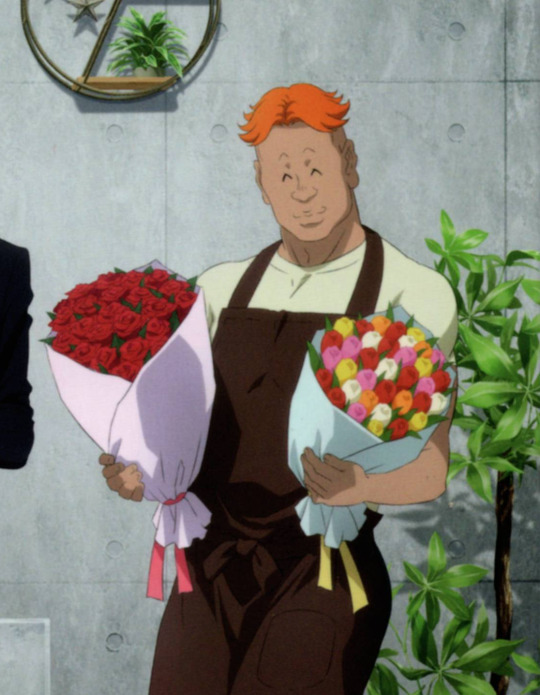
~
🌺 Hibiscus 🌺
Moving away from directly stated connections into slightly more obscure ones, Reki is nevertheless visually associated with hibiscus in several places, both in shots in the show and in his 2021 birthday art.
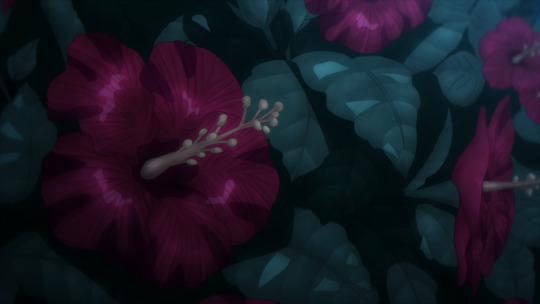
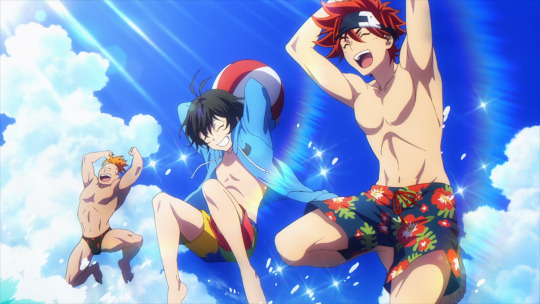
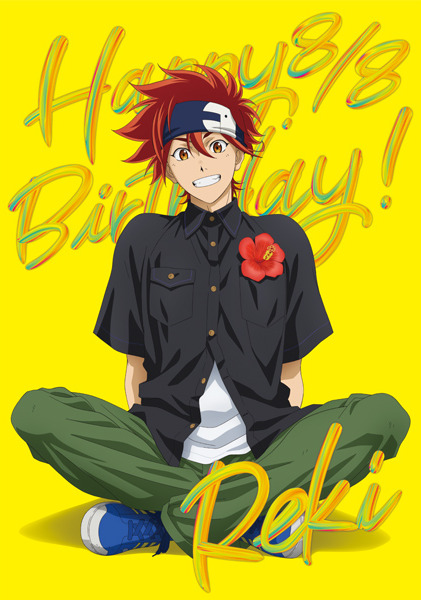
Hibiscus flowers generally can mean "new love", "trust" and "I believe in you" (a meaning thought to originate from Hinduism), while red hibiscus specifically (as Reki is depicted with) mean "bravery."
Hibiscus flowers are also considered as symbol of Okinawa as a whole, making them an especially fitting flower for Reki, who's implied to be of indigenous Ryukyuan descent and is the character who could be considered the most representative of Okinawa (and Langa's new life there) in the show,
~
🌸 Cherry Blossoms 🌸
This one is fairly self-explanatory; Kaoru's surname is Sakurayashiki (sakura being the Japanese word for cherry blossoms), his S name is Cherry Blossom, cherry blossoms feature on his costume and heavily in the decor in his calligraphy studio, et cetera. As one of the most well-known and famously Japanese flowers, they're well suited to Cherry's traditional Japanese image, and the whole aesthetic of his character is themed around them. Even his birthday is on March 27th, Sakura Day in Japan.
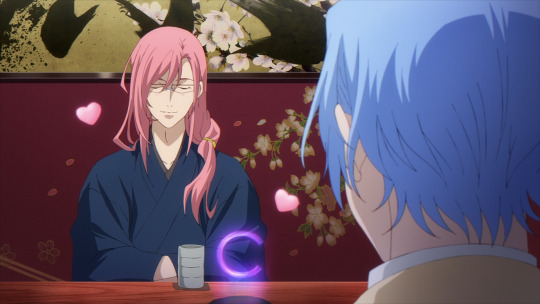
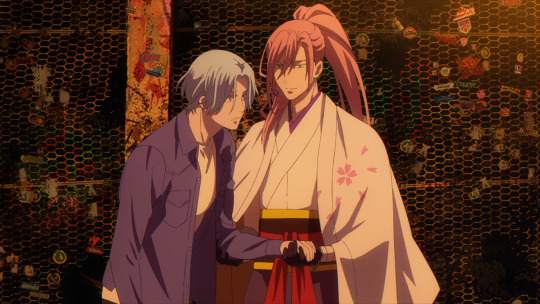
In hanakotoba, cherry blossoms' most well-known meaning is "moral beauty", a phrase referring to the beauty of someone's personality or character. They can also mean "graceful woman" or "pure-blooded", and the specific species of cherry blossom that the ones in Cherry's design resemble (somei-yoshino cherry blossoms) can additionally mean "noble" or "innocent." The fact that the same flower with such elegant meanings is related to both his public and S personas adds to the characteristic duality between his outward appearance and private personality.
While not specifically hanakotoba, the French meaning of cherry blossoms also appears to be well-known in Japan - "ne m'oubliez pas", or "don't forget me", associated with ending relationships.
~
💮 Chrysanthemums 💮
Another flower associated with a character through their surname, chrysanthemums are the "kiku" (菊) in Kikuchi. A chrysanthemum also features prominently in the design on Adam's skateboard.

Chrysanthemums also appear on both Adam and Tadashi's clothes in a few pieces of official art.
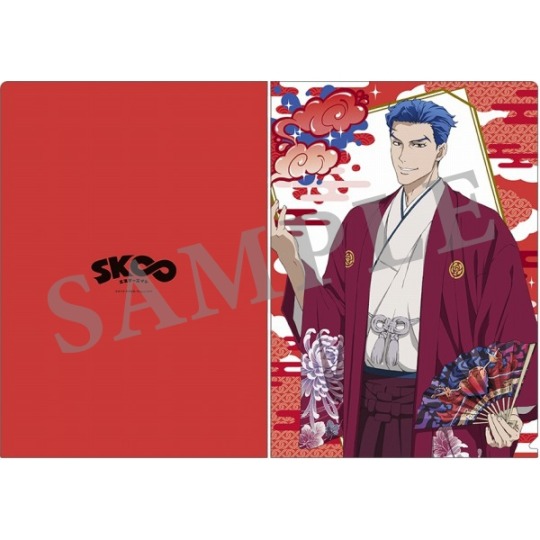
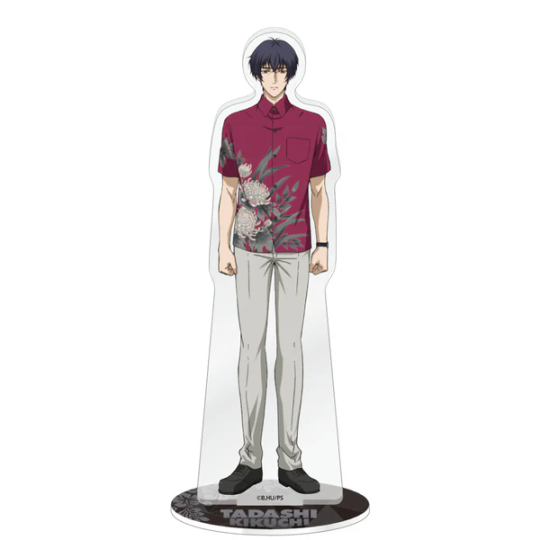
Chrysanthemums' meanings in hanakotoba are all variations of "nobility" and "purity." They're a flower with great cultural significance in Japan, being the crest of the Imperial family, and often appear as a symbol of Japanese society itself - including on the badges worn by both Diet members such as Ainosuke and even certain ones worn by their secretaries, making this flower one that's representative of a very important aspect of both their lives.
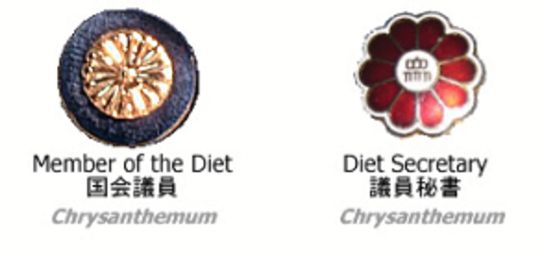
While there's no particular history to this meaning, due to the romantic color, red chrysanthemums such as the one on Adam's board can also mean "I love you."
According to director Utsumi in the 2022 Infinity Week livestream, the chrysanthemum on Adam's board was a happy accident, as Thomas Romain, the artist who designed the board, didn't know Tadashi's name or anything about his history with Adam when creating it. The double layer of symbolism is an incredible coincidence!
~
🌻 Sunflowers 🌻
Joe doesn't have any particular connection with flowers in the show himself, but there is one piece of official art featuring him with sunflowers, which complement the strong association he does have with the sun.
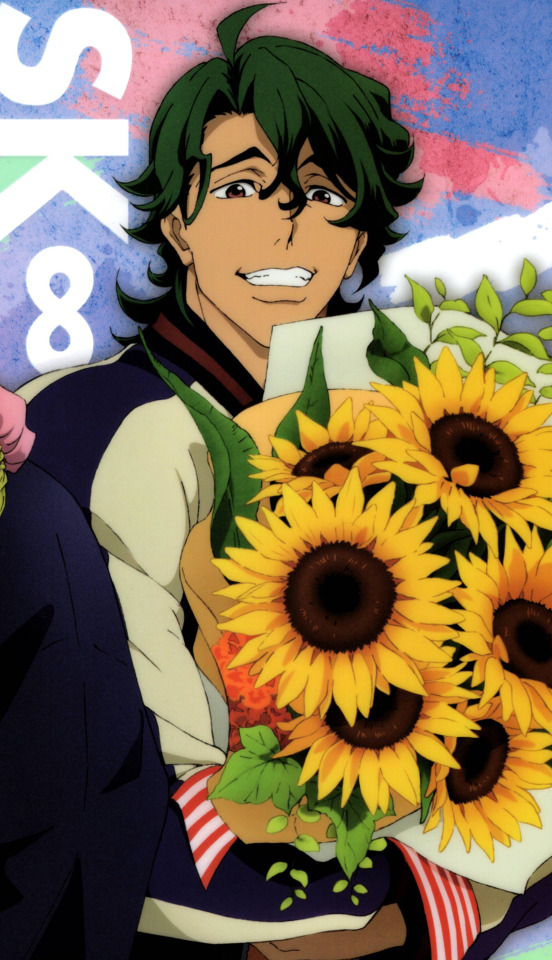
In hanakotoba, sunflowers mean "admiration", "longing" or "I'm only looking at you" - originating from the way sunflowers will always turn to face the sun. As this particular piece of official art was for a magazine feature for White Day (a Japanese holiday where men receive gifts from women they gave gifts to on Valentine's Day), perhaps they're meant to be a gift to him. As Joe's stronger association is with the sun itself (his tattoo is of the sun, his board has the word "sole" - sun in Italian - written on it and a sun incorporated into the design, his restaurant's name (Sia la Luce) translates to "let there be light") he could be seen as the sun that the sunflowers (his admirers) would look towards.
Along with the hibiscus in the image, Reki's birthday event in 2021 also featured sunflowers as part of the display, fitting his yellow image color.
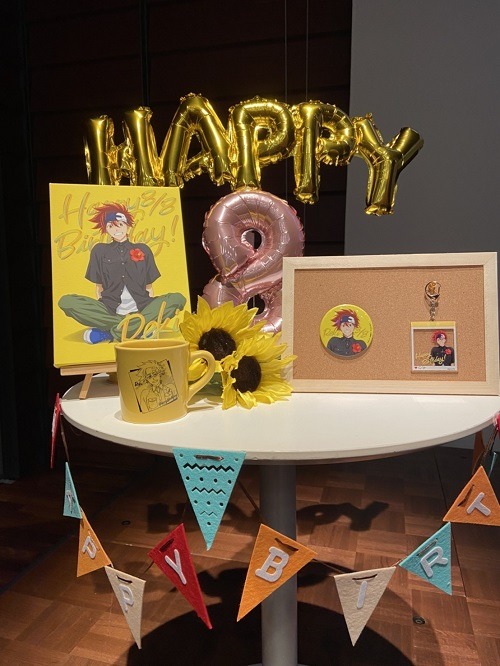
~
❄️ Snowdrops ❄️
And finally, one more case with only a single piece of official art - but one with a very interesting history behind its meanings. In Langa's 2022 birthday art, he's shown holding snowdrops - a natural association with his S name and the fact that he's a former snowboarder.
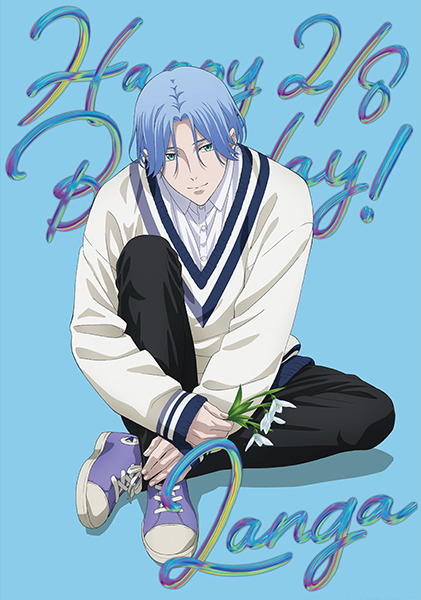
In hanakotoba, snowdrops mean "hope" and "comfort." These meanings are said, as you will find on any Japanese hanakotoba site, to originate from a story about Adam and Eve dating back to at least 1925, if not earlier (with 1925 being the earliest version of the story the Japanese Wikipedia page on snowdrops is able to cite.) As the story goes, after Adam and Eve were cast out of the Garden of Eden, an angel took pity on them suffering in the winter cold and turned the falling snowflakes into snowdrops, to console them and give them courage. In that 1925 version of the story, the first snowdrop was specifically a gift to Eve:
The Snowdrop Legend When the first winter lay white upon the earth, Eve sorely missed the beautiful things of the field. An angel who pitied her seized a snowflake and, breathing upon it, bade it live, for her delight. It fell to the earth a flower, which Eve caught to her breast with gladness, for not only did it break the spell of winter, but it carried assurance of divine mercy. Hence the flower means consolation and promise.
With both the superficial connections of being winter flowers named after snow and their connection to SK8's intentional biblical themes (as producer Mari Suzuki described the show as a whole as "the story of Adam searching for Eve" in Animedia March 2021), these have some of the deepest meanings of any of the flowers depicted, despite only appearing in a single piece of art.
The flower imagery SK8 uses is fascinating and surprisingly layered, especially knowing the deliberate attention to hanakotoba that was paid in certain cases, and it'll be interesting to see how it might continue to feature in the future.
#sk8#sk8 the infinity#meta#sk8 meta#adam sk8#ainosuke shindo#hiromi higa#reki kyan#kaoru sakurayashiki#kojiro nanjo#tadashi kikuchi#langa hasegawa
95 notes
·
View notes
Text



( "solitude" / "modesty" / "rest" / "comforting words" / "philanthropy" [purple] "tranquil" )
fuck my stupid baka life im done
i am so fucking lucky ishmael doesnt have flowers associated with her in canon or id be 10x more insane about her id be looking wayyyy too into WAIT I CAN SO DO THAT FOR HEATHCLIFF HOLD ON
#emil.rtf#i need to go play in the acid pit for a while. anyone wanna join me.#also i Know the hanakotoba one has erica the flower but erica / heather are one in the same and the site Does acknowledge that saying heath#is another term used for it and funnily enough it mentions wuthering heights. lol.
3 notes
·
View notes
Text
Módào Zǔshī Hanakotoba Analysis Part 2
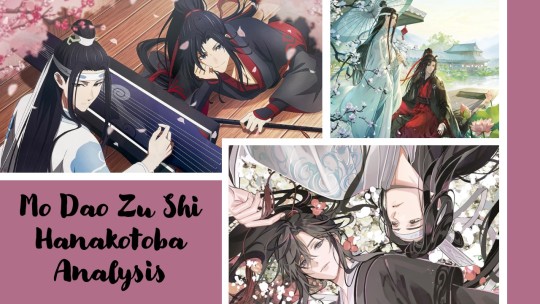
◤━━━━━━━━━◥✿◤━━━━━━━━━◥
-> 4) Lotus/Water Lily
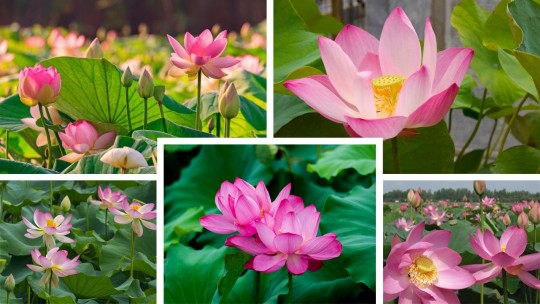


-> 4.1.) Lotus/Water Lily Flower Symbolism:
Despite having a few differentiating characteristics, lotuses (Nelumbo nucifera) and water lilies (Nymphaea) are often confused with one another. As a result, there is a lot of overlap in their symbolic meanings, to the point that they convey the same sentiments across multiple cultures. In China, lotuses are known as lián huā (蓮花) or hé huā (荷花), whereas water lilies are known as shuìlián (睡莲) and héhuā (荷花). Lotuses are known as the "gentleman's flower" in China because they grow upwards pure and unstained from the mud. The flower is thus associated with perseverance, elegance, resilience, as well as ultimate purity of mind and heart. The lotus is revered as a sacred flower in Buddhism, representing the essence of divine beauty, wisdom, humility grace and rebirth. It is also a sign of moral integrity, emphasising the importance of maintaining inner purity and virtuous behaviour in the face of worldly temptations. The word “l蓮” (lián) also sounds like “連續” (liánxù) which means continuous. This conveys the idea of constant growth and spiritual progress thus making the lotus a symbol of the continuous pursuit of knowledge, wisdom, and enlightenment. The lotus also has profound significance in Taoism, representing serenity, balance, and the "interconnectedness of all things and the inherent harmony within the universe". The lotus' adaptability to various environments embodies the Taoist concept of living in harmony with nature, flowing with life's rhythms, and preserving equilibrium in the face of change. Additionally, the lotus' ability to rejuvenate and blossom year after year, despite the shifting seasons, represents the continuous cycle of life, death, and rebirth. Part of the lotus flower’s Chinese name “l蓮” (lián) is homophonous with the words “聯” (lián) meaning “to bind/connect as in marriage”; “戀” (liàn) meaning to love; and “廉” (lián) meaning modesty. As a result, the lotus flower has also come to symbolise union, love and marriage in Chinese culture and is thus a prominent motif in both historical and modern works to convey love and emotion. Lotuses are commonly used in bridal bouquets as a symbol of luck and 100 years of love. A single stem bearing two lotus flowers represents the desire for harmony and a shared heart. This is derived from the fact that the “荷” (hé) in the lotus’ other Chinese name also means “union” and is homophonous with the word “和” (hé) meaning uninterrupted or one after another. Furthermore, a lotus flower with a leaf and bud symbolises complete union. In Japan, lotuses are called ren (蓮) or hasu (はす), while water lilies are called suiren (睡蓮). In hanakotoba, lotuses symbolise a pure heart, eloquence, sacredness and departing love—while water lilies symbolise a pure heart, faith and trust. Additionally, both flowers are also associated with rebirth, transformation, enlightenment, beauty, grace, and perfection. In Western floriography, water lilies symbolize purity of the heart, virtue, innocence, achieving great things, beauty rising from humble beginnings and bringing together separate things. Pink waterlilies are commonly associated with feelings of admiration. Since its scientific name was derived from the mythical Greek nymph, water lilies also symbolise dangerous beauty and estranged love.
-> 4.2.) Lotus'/Water Lilies in MDZS:
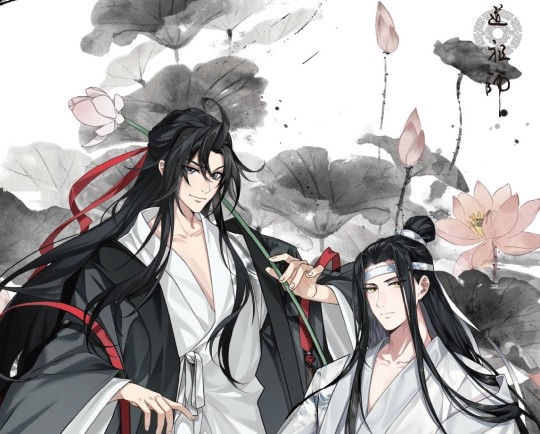

Lotuses are the most commonly referenced flower in MDZS, and they are generally associated with the Yunmeng Jiang clan. This is due to the clan's insignia, a nine-petaled lotus, as well as the name of their residence, Lotus Pier. According to the novel, the compound is surrounded by “pink blossoms with broad jade-green leaves rose from the depths of the lake, whose waters spanned hundreds of kilometres […] giving the lovely scenery a sort of charming innocence” (MXTX, v. 3, p. 9).
The lotus’ symbolic meanings best embody the characters of Jiang Yanli and Wei Wuxian. > 4,2,1) Jiang Yanli: The flower's symbolic representation of virtue, modesty, innocence, beauty, faith, grace, and purity of the heart perfectly conveys Jiang Yanli's kind and caring demeanour. Jiang Yanli's relationship with Jin Zixuan is a key aspect of her character. The lotus' symbolism of love, union, marriage, and a shared heart corresponds with this. Additionally, in both the web drama and MDZS Q, Jin Zixuan grows lotus flowers as a gift for Jin Yanli. > 4,2,2) Wei Wuxian: Wei Wuxian's life can be divided into three parts: his time as the first disciple of the Jiang clan, his time as the Yiling Laozu, and his life after his resurrection as Mo Xuanyu. During his youth with the Jiang clan, he was a promising upcoming cultivator with a humble background. Despite displaying a mischievous and carefree attitude, he was intelligent, dedicated, virtuous and possessed a strong sense of justice. This ties into the lotus’ symbolism of flowing with life's rhythms, wisdom, perseverance, virtue and beauty from humble beginnings. As the Yiling Laozu, he defies convention by developing an unorthodox cultivation path that deviates from the norm. This corresponds with the lotus' symbolism of the continuous pursuit of knowledge, wisdom and achieving great things. He is determined to protect the innocent regardless of prejudicial beliefs—however, this sense of justice renders him capable of brutality at times. This is what inevitably results in him being seen as an outcast in the cultivation world. Ultimately, his power overwhelms him, causing many casualties given that “no one can walk along a single-plank bridge their entire lives and never fall” (MXTX, v. 2, p. 173). This turn of events all juxtaposed against the lotus’ symbolism of preserving stability in the face of change and achieving ultimate purity of mind and heart. After his resurrection, as a result of his experiences as both a hero and a pariah to the cultivation world, Wei Wuxian sees nuance where many do not and often expresses regret and admits his faults—“You’re not the only ones who remember what I’ve done. I remember too. You won’t forget—what makes you think I will?” (MXTX, v. 4, p. 174). This ties into the lotus’ symbolism of wisdom, constant growth and spiritual progress as well as the continuous cycle of life, death, and rebirth. Additionally, his courtesy name Wuxian (无羡) is derived from the last line of a poem by Xu Ben which translates to “to be free of envy and aspire to greater heights; not be misguided by honorary reputation and personal gain”. This ties into the lotus’ symbolism of maintaining inner purity and virtuous behaviour in the face of worldly temptations.
-> 5) Peony
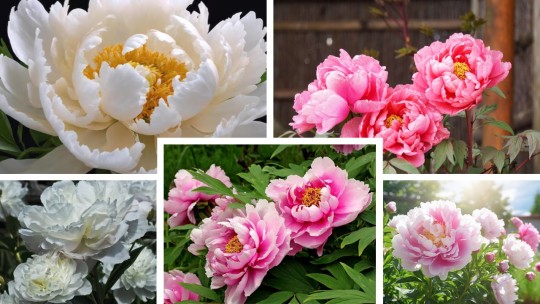


-> 5.1.) Peony Symbolism:
Peonies (Paeonia) are known as mǔdān (牡丹) in China and were regarded as China’s national flower during the Tang Dynasty (618 to 907 A.D.). In accordance with this, they symbolise prosperity, honour, wealth and beauty, love and happiness. The Chinese term for peonies means "the most beautiful” while other Chinese names for peonies are "fùguìhuā" and "huawang," which translate to "king of the flowers" and "flower of riches and honour," respectively. In Japan, peonies are called botan (牡丹) and symbolize shyness, wealth and regalness in hanakotoba. The flower's profound appearance, notably its multitudes of large petals that are thin and silk-like, is where the peony’s symbolism of wealth and regalness originated. In Western floriography, peonies represent bashfulness and compassion.
-> 5.2.) Peonies in MDZS:
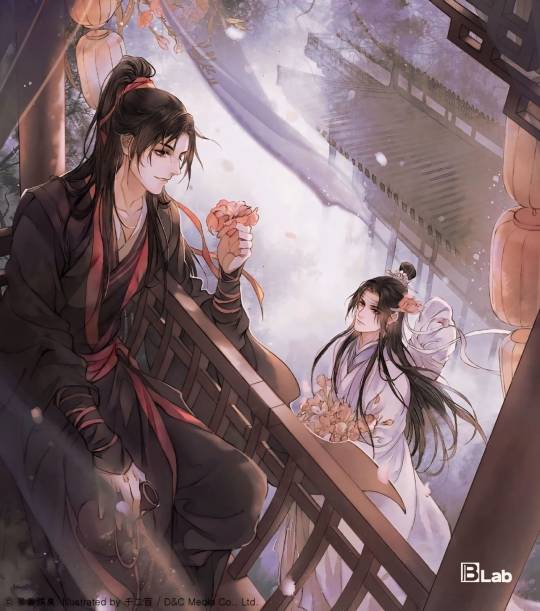
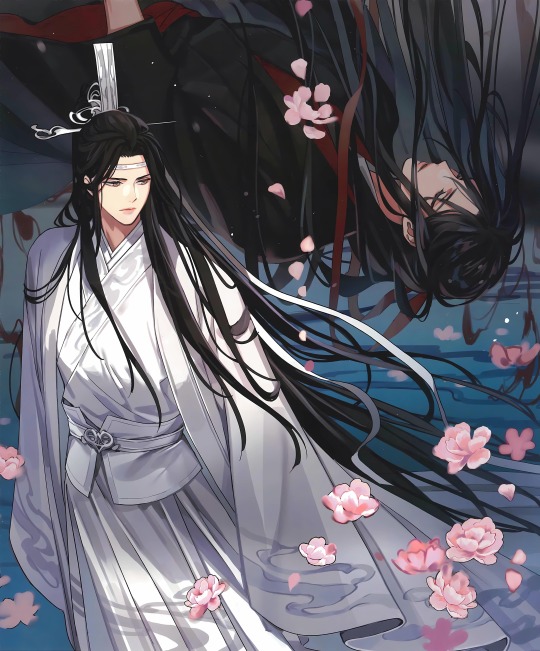
In the series, a white peony cultivar named “Sparks Amidst Snow” is used as the symbol of the Langling Jin Clan. It is said that “by comparing themselves to the king of flowers, they implied they were kings among immortals” (MXTX, v.1, p. 65). This ties in with the peony flower’s symbolic meanings of prosperity, wealth, honour and regalness. Furthermore, pink peonies are often associated with the novel’s central love story between Wei Wuxian and Lan Wangji. During the Siege Hunt at Mount Baifeng, Wei Wuxian throws a pink peony to Lan Wangji amidst the parade. Later, while on a trip to Yunmeng, the latter once again encounters Wei Wuxian who throws him another pink peony. In this audio drama adaptation of this scene, Wei Wuxian asks a ghost woman what the meaning of peony is, and she responds that it means "wishing you would return my feelings" or to part with a heavy heart." Years later, following Wei Wuxian's death and resurrection, he finds a pressed peony flower that Lan Wangji uses as a bookmark. This peony was noted by Wei Wuxian as being “extremely well preserved, [with] the colours still vivid and the veins on its petals so delicately textured that it still looked alive” (MXTX, v. 3, p. 191). Given Lan Wangji's sentimental nature, this peony is undoubtedly one of those given to him by Wei Wuxian. The flower’s association with the pair ties into its symbolic meanings of love, compassion, and happiness.
-> 6) Willow Tree
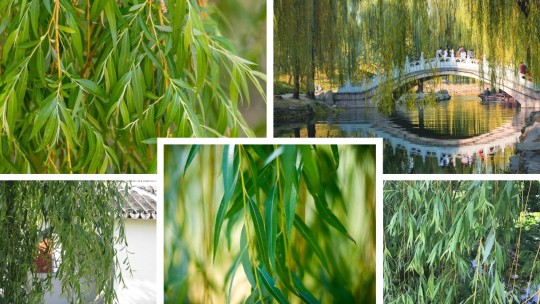


-> 6.1.) Willow Tree Symbolism:
Willow trees are known as liǔ (柳) in China. They are regarded as a symbol of friendship, long-lasting affection, and "urging someone to stay." Willow trees are also connected with spring, therefore they can represent renewal, resilience, the cyclical cycle of existence and the revival of life after a dormant period in winter. Additionally, the willow tree's supple branches can convey an image of meekness and humility. The willow tree's interwoven branches symbolise the depth of friendship because similarly to how branches connect and support one another, genuine friendship is also based on trust, understanding, and mutual support. The willow tree is also associated with separation from loved ones, prompting feelings of sorrow and longing. Willow branches are commonly utilised in Chinese funeral rites as a symbol of grief and remembrance. Willows, known in Japan as yanagi (柳), represent obedience, independence, and the melancholy of love in hanakotoba. The willow’s symbolism of obedience is derived from how its leaves sway in the wind. In contradiction with this, its symbolic meaning of freedom also stems from how freely its leaves sway in the wind. In Western floriography, willows are associated with both freedom and sadness. Weeping willows in particular represent grief, melancholy, and mourning.
-> 6.2.) Willow Trees in MDZS:


Given its symbolic meanings, willow trees can be associated with Jiang Cheng and Wei Wuxian’s complicated, but strong dynamic. This is supported by Wei Wuxian specially mentioning a willow tree when remising about his youth spent in Lotus Pier with Jiang Cheng—“there was an old willow tree rooted on the bank, with a thick, sturdy trunk that slanted over the water and branches that trailed onto its surface. The boys of Lotus Pier would often walk along the trunk of this particular willow tree to sit and fish from the treetop” (MXTX, v. 3, p. 109). While the duo's bond started as one of trust, support, and mutual understanding, it has distorted into one of melancholy, mourning, and longing. This juxtaposition encompasses all of the willow's connotations across various cultures. The willow’s association with spring, renewal, resilience and revival could be indicative that Jiang Cheng and Wei Wuxian’s bond could be repaired if given time, considering that they never properly reconciled because of Jiang Cheng’s reluctance—“But just as the Wei Wuxian of the past who’d extracted his golden core for Jiang Cheng had been unable to tell him the truth, the Jiang Cheng of the present could no longer bring himself to speak up” (MXTX, v. 5, p. 127).
◣━━━━━━━━━◢✿◣━━━━━━━━━◢
╰┈➤ Part 1
╰┈➤ TGCF Hanakotoba Post Part 1
╰┈➤ Other Hanakotoba Posts
[Please check out part 1 as well! If anyone has any ideas on what anime/anime theme song I should cover next in this series please lmk✿ Also, if you liked this post, check out my other hanakotoba analysis posts... Lastly, if I've gotten any of the kanji, romaji, hanzi or pinyin incorrect, feel free to correct me]
#mdzs#mo dao zu shi#grandmaster of demonic cultivation#the grandmaster of demonic cultivation#mxtx#mxtx mdzs#mo xiang tong xiu#donghua#danmei#anime#anime hanakotoba#hanakotoba#floriography#hanakotoba analysis#mdzs donghua#wei wuxian#wei ying#lan wangji#lan zhan#wangxian#wuji#wei wuxian x lan wangji#wei ying x lan zhan#jin zixuan x jiang yanli#jiang yanli#jiang cheng#jin clan#jiang clan#mdzs wwx#mdzs lwj
44 notes
·
View notes
Text
The flower that represents Ryuichi Naruhodo (Phoenix Wright)
Hello
I came to you with a tiny post
(I'm not lost and I'm not going anywhere.)
Because we missed an important detail again!
My favorite case is 3-1. In which there is just a huge pile of information.
When Chihiro interrogates a witness about the reason for her interest in Naruhodo, she gives an answer in the form of a haiku (although it is difficult to assess its correctness).


・・・・はかなげな、日かげに咲いた タンポポのような、たたずまい・・・・
hakana ge-na, bikageni saita tanpopo no yōna, tatazumai
... An ephemeral dandelion blooming in the shade...
リュウちゃんの、そんなところに ヨロめいてしまったのですわ。
ryuu-chan no, son'na tokoro ni yoro meite shimatta nodesu wa.
That's what Ryu-chan is like, and that's what made me fall for him.
儚い (はかない)
hakanai
• fleeting; transient; short-lived; momentary; ephemeral; fickle; vain
儚い or 儚げな can be used positively to describe some type of beauty found within weak/unstable/delicate things or people. It may be similar to so-called wabi-sabi.
げな (ge-na) - express the guess (it seems)
Madame literally calls Naruhodo "an ephemeral dandelion"
And gives a lot of food for thought, as it can be interpreted in many ways. After all, it is not just a randomly chosen flower.
The first thing that comes to mind is hanakotoba
In Hanakotoba (花言葉) Dandelions mean:
神託 (Oracle)
別離 (Separation)
幸福 (Happiness)
真心の愛 (Sincere Love)
愛の神託 (Oracle of Love)
Dandelions are known to be a fortune-telling flower which is why words like “神託 (Oracle)” are associated with it.
No less important meaning: dandelion is a symbol of courage, strength. Because this plant is able to grow in any conditions, and breaking through the asphalt, reaching for the sun.
Dandelion flowers also carry a meaning of wishing an ill person well, or happiness in times of darkness.
Suits our boy, doesn't it?
He represents each meaning: he was separated from his friend, he loved sincerely, he had a cold during the court hearing, and he found the strength to move on, making his own way when he was in unbearable pain.
We've dealt with the dandelion, now let's return to the "ephemeral".
On the one hand, everything is simple - dandelions look unreliable, weak, especially during the period of seed ripening. They are easily blown away by a weak breeze. Beauty and attractiveness that not everyone will appreciate. Why not ephemeral.
However, there may be much more meaning here. After all, another meaning is: short-lived
And then the phrase as a whole takes on a frightening meaning. She's literally says: he (the dandelion) will not be in this courtroom (in the darkness) for long. She literally predicts a "guilty" verdict for him, especially given her subsequent words. This is what she feels, what she wishes for him - to disappear into the darkness.
But her plans are not destined to come true, because the dandelion grows even through the asphalt.
___________________________________________
Well, and for comparison.


Mushrooms are often associated with spiritual growth, enlightenment, and rebirth. The mushroom's life cycle, with its ability to emerge from darkness and decay, represents the cyclical nature of life, death, and transformation.
This is probably a reference to Phoenix's name. Probably. That's all.
What do you think?
#ace attorney#gyakuten saiban#phoenix wright#naruhodo ryuichi#i said what i said#and yes i will use japanese names because i want to and i played the game with them. no complaining.#dahlia hawthorne#chinami miyanagi
30 notes
·
View notes
Note
I scroll through your blog like it’s the news with my afternoon tea sometimes, and I have to say: you didn’t know you had a hanakotoba thing goin on?? Cause like, it’s such a thing in your fics it’s one of the first things I think of lololol. If you had ever done one of those ‘when you think of my fics, what do you think of first’ ask games I would have been like ‘your very obsessed with flowers, and having flowers be symbolic in your fics’. 🤣
(Well, I hope you enjoy having my blog as your afternoon tea entertainment hahaha)
I know I had an entire series dedicated to hanakotoba in my FE3H fics but I honestly only thought it was White Aster and The King for my AC fics. I didn't realize fiat also had it. I'll own up to it though 'cause I love having symbolism in my fics hahahaha
But hey, at least I haven't made an entire post of just me giving each AC protagonist their symbolic flower hahahaha (i would totally give desmond anemone because it means 'abandoned' and 'thrown away' which is what ubisoft did to our poor boy!)
#ask and answer#hanakotoba is one of those topics i've loved since i was a kid#and i'll keep using them whenever i feel like it#or whenever my writing decided 'yeah it's time to add flower symbolism here'
2 notes
·
View notes
Text

Sesshomaru and Irene, based off the With You ending!
Quite possibly the most complicated drawing I have ever drawn.
Snow and flower symbolism explanation time!
"The camellia (aka-tsubaki) is often a symbol of strong love. However, these flowers also hold other symbolism. Traditionally, camellias were tied to samurais. These military warriors looked upon the winter-blooming camellias as symbols of bravery and strength against all odds. Samurais also took meaning from the sudden way these flowers die.
As other flowers slowly lose one petal then another, camellia flowers quickly and fully fall from the plant. Samurais hoped the camellia’s quick death would mirror how they killed their opponents. Since samurais had special relationships with camellias, Japanese people often used these flowers to honor fallen samurai.
In hanakotoba, the meaning of red camellia (aka-tsubaki) can mean in love or perishing with grace."
Irene has accepted her feelings for Sesshomaru, so she's holding the camellia bloom gently with both hands and looking back at him, but Sesshomaru, while no longer in denial now that she's returned, refuses to act on the feelings he's realized he has, and so while he is looking at her he has crushed the flower in his palm- as if in an effort to "crush" the feelings that he has.
As for the snow...
There's a reason for it that will eventually be revealed in the fic, but for now we'll go with the fact that, to Sesshomaru, Irene vanishes and reappears like freshly fallen snow. One minute she's there, the next she's gone (melted away) as she's returned back to her era, before eventually making her way back to the feudal era in the middle of the winter season.


Version without the hat and a version without the shadows and lighting!
The original version-

32 notes
·
View notes
Text
【Magi】 JuAli Scenario Idea: Flower Crowns 🖤❤️💛
Intro



Judar spots Alibaba and Kougyoku making flower crowns, so Alibaba makes a flower crown for Judar. After being given a gift of bouquets (sunflowers) by Alibaba, Judar asks Kougyoku later what flowers to get as a return gift 🌻💐
I quickly wrote it this morning. I forgot to post this writing idea I had whoops 😭
Judar and Alibaba's friendships with Kougyoku is everything to me
I've always wanted to write about the 3 of them together~ JuAli with their bestie Kougyoku hehe

Judar, Kougyoku, and Alibaba sketch by Ohtaka
Flower Symbolisms
If you haven't seen it, feel free to check out my Flower Symbolisms post:
PW: meowmeowcollection

I'll put it here nonetheless, but it contains the context for my scenario idea
JuAli Scenario Idea
This is gonna be new from me, usually I post just the dialogue script itself and my rambles under, but since I wrote this quickly, this is gonna be a combination of my rambles + dialogue ideas
It's a huge WIP so I still have to add to it










As said before, JudaAli (ジュダアリ) is the Magi JP fandom's main ship name for them. It also has a cute sounding ring to it~ I've seen JuAli (ジュアリ) used a bit in the JP fandom.
I like typing the shorter one, it makes my life easier HAHA
Due to the common "First few characters of each characters' name is used and combined as a ship portmanteau" ship naming convention in EA fandom
Though sometimes, other characters may be chosen for better aesthetics.
Kougyoku my wife <333
I also want to write more of her in general too when I get the time
The idea came to mind yesterday. I'd love to draw this sometime in the future (not now cuz I'm slow)
Since I wrote it quickly, it's not as refined as my other ideas. So it's a mix of my rambles and bits of dialogue I came up with
Hopefully I'll get to refine & add to it soon 👍
Huge rough draft WIPs
Just wanted to get the ideas down so I don't forget
I thought about it recently when I was coming up with flower picks for my faves based on Hanakotoba meanings
In terms of meaning, I chose red hydrangeas and sunflowers for JuAli 💐🌻
They also fit colours wise and thematically too!
Also for the Flower Symbolisms post. I'm still planning to add more flower picks for JuAli eventually 🙏
I had a list of potential ideas in my rough drafts, I just need to check them over and see which ones are good
Since I spend time looking at Hanakotoba meanings and seeing if my interpretations align, specifically how I interpret the Hanakotoba meanings in JP). I also check JP florists' blogs to see other popular/common interpretations that may not be included on the Hanakotoba official site
And I'll be looking into more flowers too 😌
#magi#juali#judar#alibaba#alibaba saluja#judali#judaali#judar x alibaba#judal#judal x alibaba#aliju#magi: the labyrinth of magic#judar magi#judal magi#sen's ideas#sen's rambles#ren kougyoku#kougyoku ren#kougyoku
20 notes
·
View notes